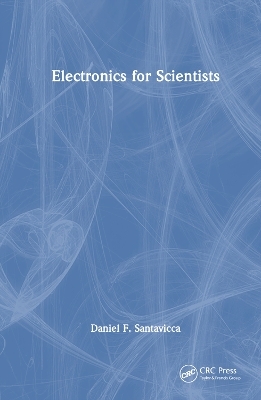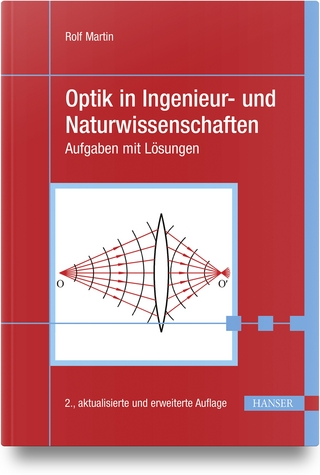
Electronics for Scientists
Seiten
2023
CRC Press (Verlag)
978-1-032-52812-0 (ISBN)
CRC Press (Verlag)
978-1-032-52812-0 (ISBN)
Electronics for Scientists provides a practical and concise introduction to electrical circuits, signals, and instrumentation for undergraduate students in the physical sciences. No previous familiarity with electronics is required and concepts are grounded in the relevant physics. The book aims to give students the electronics background needed to be successful in experimental science.
The book begins with the fundamentals of DC circuits. This is followed by AC circuits and their analysis using the concept of impedance. The transfer function is introduced and used to analyze different types of filter circuits. The conversion between time-domain and frequency-domain signal representations is reviewed. Transmission lines are introduced and used to motivate the different approach to designing microwave-frequency circuits as compared to lower-frequency circuits. The physics of semiconductors is reviewed and used to understand the behavior of diodes and transistors, and a number of diode and transistor circuits are analyzed. The operational amplifier (op-amp) is introduced and several op-amp circuits are analyzed. Techniques for quantifying noise in electrical measurements are described and common sources of noise are discussed. The last major topic is digital circuits, which include analog-to-digital conversion, logic gates, and digital memory circuits. The book concludes with a brief introduction to quantum computing.
Designed for a one-semester course, this book brings together a range of topics relevant to experimental science that are not commonly found in a single text. Worked examples are provided throughout the book, and each chapter concludes with a set of problems to reinforce the material covered. The subject of electronics is indispensable to a wide array of scientific and technical fields, and this book seeks to provide an approachable point of access to this rich and important subject.
The book begins with the fundamentals of DC circuits. This is followed by AC circuits and their analysis using the concept of impedance. The transfer function is introduced and used to analyze different types of filter circuits. The conversion between time-domain and frequency-domain signal representations is reviewed. Transmission lines are introduced and used to motivate the different approach to designing microwave-frequency circuits as compared to lower-frequency circuits. The physics of semiconductors is reviewed and used to understand the behavior of diodes and transistors, and a number of diode and transistor circuits are analyzed. The operational amplifier (op-amp) is introduced and several op-amp circuits are analyzed. Techniques for quantifying noise in electrical measurements are described and common sources of noise are discussed. The last major topic is digital circuits, which include analog-to-digital conversion, logic gates, and digital memory circuits. The book concludes with a brief introduction to quantum computing.
Designed for a one-semester course, this book brings together a range of topics relevant to experimental science that are not commonly found in a single text. Worked examples are provided throughout the book, and each chapter concludes with a set of problems to reinforce the material covered. The subject of electronics is indispensable to a wide array of scientific and technical fields, and this book seeks to provide an approachable point of access to this rich and important subject.
Daniel F. Santavicca is a Professor of Physics at the University of North Florida, where he also serves as the founding Director of the interdisciplinary graduate program in Materials Science and Engineering. He received a PhD in Applied Physics from Yale University and runs an active research program in nanoscale electronics with a focus on superconducting thin film devices.
1 Linear DC Circuits. 2 Linear AC Circuits. 3 Four-Terminal Circuits and the Transfer Function. 4 Transmission Lines. 5 Semiconductor Devices. 6 Operational Amplifier. 7 Noise. 8 Digital Circuits
| Erscheinungsdatum | 08.09.2023 |
|---|---|
| Zusatzinfo | 11 Tables, black and white; 80 Line drawings, black and white; 80 Illustrations, black and white |
| Verlagsort | London |
| Sprache | englisch |
| Maße | 156 x 234 mm |
| Gewicht | 453 g |
| Themenwelt | Naturwissenschaften ► Physik / Astronomie ► Optik |
| Technik ► Elektrotechnik / Energietechnik | |
| Technik ► Umwelttechnik / Biotechnologie | |
| ISBN-10 | 1-032-52812-5 / 1032528125 |
| ISBN-13 | 978-1-032-52812-0 / 9781032528120 |
| Zustand | Neuware |
| Informationen gemäß Produktsicherheitsverordnung (GPSR) | |
| Haben Sie eine Frage zum Produkt? |
Mehr entdecken
aus dem Bereich
aus dem Bereich
Grundlagen - Verfahren - Anwendungen - Beispiele
Buch | Hardcover (2022)
Hanser, Carl (Verlag)
49,99 €
Aufgaben mit Lösungen
Buch | Hardcover (2023)
Hanser, Carl (Verlag)
29,99 €


